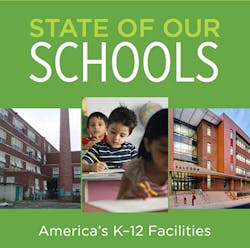The federal government and individual states need to allocate greater amounts of funding and distribute the dollars more fairly to help provide the $46 billion a year in additional spending needed to provide safe, healthful and efficient K-12 school facilities.
That’s the conclusion of a new report, State of Our Schools: America’s K-12 Facilities, produced by the U.S. Green Building Council’s Center for Green Schools, the 21st-Century Fund, and the National Council on School Facilities.
Researchers reviewing historical spending data of public school districts estimated that districts nationwide have been spending $99 billion a year on facilities—$50 billion on maintenance and operations, and $49 billion on capital construction and new facilities.
But to bring all U.S. public school facilities up to modern standards—healthful, safe, educationally appropriate and environmentally sustainable—districts should be spending $145 billion a year.
“Most states and districts do not have what they need to take care of the facilities they already have—or to build new facilities,” the report asserts. “Despite the average $99 billion annual investment over the past 20 years, the nation needs an additional $8 billion a year for M&O and an additional $38 billion a year for capital construction to catch up on deferred maintenance, to renew and alter existing facilities to address changing educational requirements, and to cover new construction.”
Compounding the problems that arise from inadequate funding is that the support for school facilities varies widely from state to state. In many cases, lack of support leaves local school districts, some wealthy, some poor, with most of the financial burden for paying for education facilities. The result is that major facilities inequities have developed and grown worse among haves and have-nots.
“Some children learn in state-of-the-art school buildings, with the most modern labs, classrooms, and computer centers available,” the report says. “But too many students suffer in buildings that were out of date decades ago and are an embarrassment in the world’s richest country. Because local wealth is the primary source of capital construction funds, underinvestment disproportionately affects children from low-income families. The results affect both students’ well-being and their educational opportunities.”
Twelve states provide no capital construction funding to districts, and 13 more states provide less than 10 percent of what is spent on capital projects, researchers found.
One solution the report advocates is for the state governments that provide little or no support to local districts for school construction and renovation to step up their efforts.
“A critical step is to identify state-level solutions to ensure equitable educational opportunities for all,” the report says.
Another way to eliminate funding inequities is for the federal government to earmark funding for school construction. Federal funding makes up about 10 percent of the average school district’s operating budget, but federal sources contribute almost nothing to school systems’ capital costs.
“It is time to explore how the federal government can help eliminate extreme inequities in school facilities conditions,” the report urges. “It is time for a non-partisan dialogue on the appropriate federal role for helping states and districts meet our collective responsibilities.”
About the Author
Mike Kennedy
Senior Editor
Mike Kennedy, senior editor, has written for AS&U on a wide range of educational issues since 1999.

